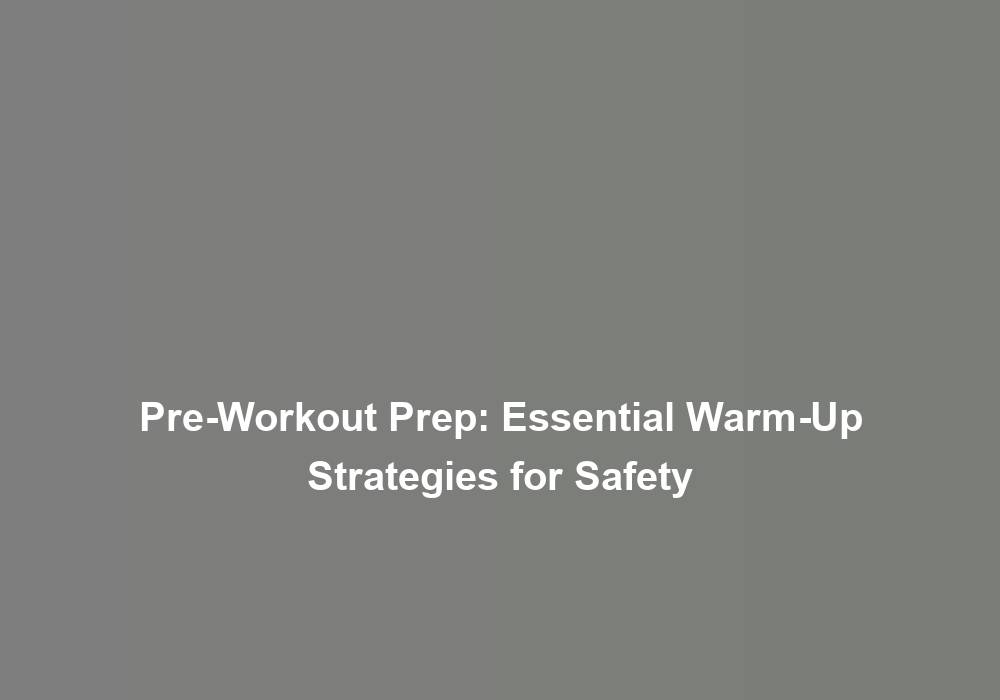Pre-Workout Prep: Essential Warm-Up Strategies for Safety
Imagine yourself standing in a dimly lit gym, surrounded by the hum of treadmills and the clinking of weights. YouG??re about to embark on a challenging workout, but before you jump into the intensity, itG??s crucial to prepare your body for whatG??s to come. The right warm-up can make all the difference in preventing injury and maximizing your performance. How can you ensure that your warm-up is not just a formality, but an essential part of your workout routine? Stay tuned to learn about the key strategies that will set the stage for a safe and effective workout session.
Importance of Warm-Up
Before beginning any workout, itG??s essential to understand the importance of a proper warm-up to prepare your body for the physical activity ahead. A warm-up serves as a crucial step in injury prevention and performance enhancement. By gradually increasing your heart rate and circulation, a warm-up helps to loosen your muscles, making them more pliable and less prone to strains or tears during your workout. It also increases the flexibility of your tendons and ligaments, reducing the risk of injury. Additionally, a warm-up primes your cardiovascular and respiratory systems, ensuring that they can meet the increased oxygen demand during your workout, ultimately enhancing your overall performance.
Dynamic Stretching Techniques
To build on the importance of a proper warm-up, incorporate dynamic stretching techniques to further prepare your body for the physical activity ahead. Dynamic stretching involves continuous movement to increase blood flow, flexibility, and range of motion. This type of stretching is especially beneficial for injury prevention and flexibility training before a workout. Here are some dynamic stretching techniques to consider incorporating into your warm-up routine:
-
Leg Swings: Stand tall and swing one leg forward and backward, then side to side, ensuring that the movement comes from your hip joint. This helps to warm up your hip flexors, hamstrings, and quadriceps.
-
Arm Circles: Extend your arms to the sides and make circular motions, gradually increasing the size of the circles. This movement warms up your shoulder joints and the muscles surrounding them.
-
Walking Lunges: Take a step forward into a lunge position, ensuring your front knee does not extend past your toes. Alternate legs as you walk forward, which helps to stretch your hip flexors and improve lower body flexibility.
-
Torso Twists: Stand with your feet shoulder-width apart and twist your upper body from side to side. This movement helps to warm up your core muscles and improve spinal mobility.
Incorporating dynamic stretching techniques into your warm-up routine not only prepares your body for the workout but also reduces the risk of injury and improves overall flexibility, thereby enhancing your performance during physical activity.
Activation Exercises for Key Muscles
Consider incorporating activation exercises to engage key muscles before your workout, as this can enhance your overall performance and reduce the risk of injury. Activation exercises are essential for preparing your body for more intense movements during your workout. For example, focusing on hip mobility before lower body exercises can help you achieve better form and prevent strain on your lower back and knees. Simple exercises like hip circles, leg swings, or hip flexor stretches can help improve your hip mobility and stability.
When it comes to upper body workouts, shoulder stability is crucial for preventing injuries and improving your overall strength. Incorporating exercises that target the rotator cuff muscles, such as external rotations with resistance bands or stability ball YWT exercises, can help activate and strengthen your shoulder stabilizers. These activation exercises can improve your posture, reduce the risk of shoulder impingement, and enhance your overall upper body strength.
Incorporating activation exercises into your warm-up routine not only prepares your muscles for the upcoming workout but also helps you establish a mind-muscle connection, which is essential for maximizing the benefits of your training. By focusing on engaging key muscles through activation exercises, you can improve your performance, reduce the risk of injury, and foster a sense of belonging to a community of like-minded individuals who prioritize safe and effective workout practices.
Cardiovascular Warm-Up
Engaging in activation exercises for key muscles primes your body for the upcoming workout, and now, letG??s focus on the importance of a dynamic cardiovascular warm-up to further prepare your body for the demands of your exercise routine. A dynamic cardiovascular warm-up not only enhances your performance but also reduces the risk of injury by gradually increasing your heart rate and blood flow to your muscles. HereG??s why itG??s crucial:
-
Heart Rate Regulation: A dynamic cardiovascular warm-up gradually increases your heart rate, preparing it for the higher demands of your workout. This helps prevent sudden spikes in heart rate during the main workout, reducing the risk of cardiovascular stress and potential complications.
-
Blood Flow Optimization: By increasing blood flow to your muscles through dynamic movements, a cardiovascular warm-up ensures that your muscles receive adequate oxygen and nutrients. This primes them for the upcoming physical activity, reducing the likelihood of muscle fatigue and enhancing endurance.
-
Mental Preparation: A dynamic cardiovascular warm-up also mentally prepares you for the workout ahead. It helps shift your focus to the exercise, allowing you to get into the right mindset for the challenges youG??re about to face.
-
Injury Prevention: Gradually increasing the intensity of your workout through a dynamic cardiovascular warm-up helps prepare your muscles, tendons, and ligaments for the impending physical activity, reducing the risk of strains and sprains.
Mind-Body Connection Exercises
Improving your mind-body connection through specific exercises can enhance your overall physical performance and mental focus during your workout routine. By incorporating mind-body connection exercises into your pre-workout warm-up, you can better prepare your body and mind for the physical challenges ahead. Two essential techniques for enhancing your mind-body connection are breathing techniques and visualization exercises.
Mind-Body Connection Exercises
| Exercise Type | Description | Benefits |
|---|---|---|
| Breathing Techniques | Deep, rhythmic breathing to calm the mind and body | Reduces stress, increases focus |
| Visualization | Mental imagery of successful workout performance | Enhances motivation, improves technique |
Engaging in breathing techniques such as diaphragmatic breathing or box breathing can help regulate your nervous system, reduce anxiety, and increase oxygen flow to your muscles, leading to improved physical performance. Visualization exercises involve mentally rehearsing your workout routine, focusing on achieving your goals, and envisioning successful outcomes. This can help boost confidence, enhance motivation, and improve overall workout performance.
Incorporating these mind-body connection exercises into your warm-up routine can create a sense of belonging within your own body, allowing you to feel more connected and in tune with your physical capabilities. By practicing these techniques, you can cultivate a heightened mind-body connection, leading to a more fulfilling and effective workout experience.
Conclusion
So, next time you hit the gym, remember to prioritize your warm-up routine. By preparing your body with dynamic stretches, activation exercises, and a cardiovascular warm-up, youG??ll set yourself up for a safe and effective workout. DonG??t forget the mind-body connection exercises too G?? theyG??re essential for getting in the zone. Just like a well-oiled machine, your body needs a proper warm-up to perform at its best.







